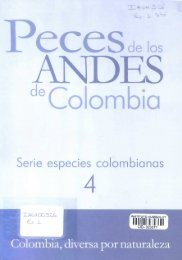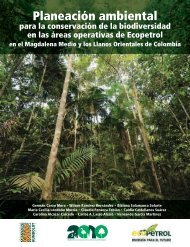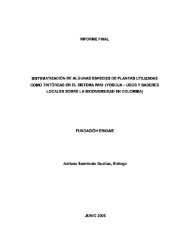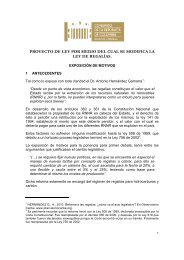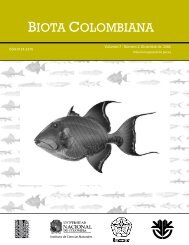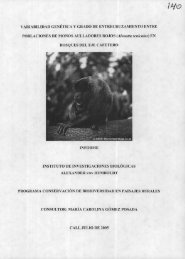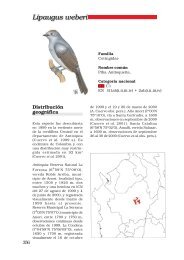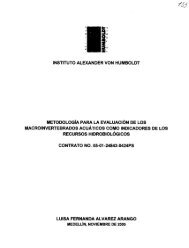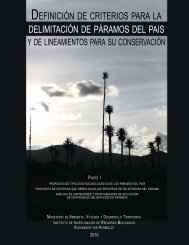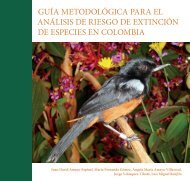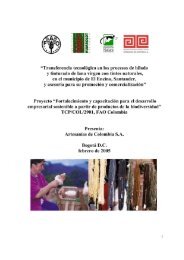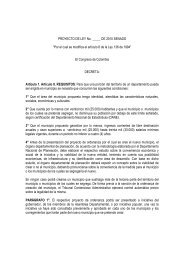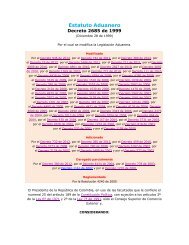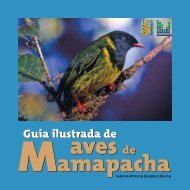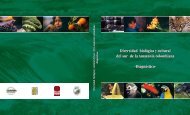PECES DE LOS ANDES DE COLOMBIA - Instituto de Investigación ...
PECES DE LOS ANDES DE COLOMBIA - Instituto de Investigación ...
PECES DE LOS ANDES DE COLOMBIA - Instituto de Investigación ...
Create successful ePaper yourself
Turn your PDF publications into a flip-book with our unique Google optimized e-Paper software.
82 <strong>PECES</strong> <strong>DE</strong> <strong>LOS</strong> AN<strong>DE</strong>S <strong>DE</strong> <strong>COLOMBIA</strong><br />
Brycon moorei Steindachner, 1878<br />
Sinonimias<br />
Othonophanes Bolívarensis Dahl, 1943: 216.<br />
Nombres comunes<br />
Dorada, dorada playera, mueluda, sardinata, pez <strong>de</strong> los siete colores, paloma, charúa, mulata.<br />
Descripción (Figura 84)<br />
Se diferencia <strong>de</strong> Brycon henni por tener A 27 - 30 (Dahl 1971) y cuya longitud es mayor que la longitud <strong>de</strong> la<br />
cabeza; ELL 55 - 68 (Howes 1982); generalmente 10 dientes multicúspi<strong>de</strong>s en cada premaxilar; dientes triangulares<br />
en la parte anterior <strong>de</strong> la mandíbula, y en la parte posterior hay dos dientes cónicos junto a la sínfisis<br />
característica <strong>de</strong>l género; su línea lateral es completa y fuertemente curvada hacia abajo; por la coloración <strong>de</strong>l<br />
cuerpo se le ha dado el calificativo <strong>de</strong>l pez <strong>de</strong> los siete colores, ya que la parte baja <strong>de</strong> la cabeza y la región<br />
pectoral son amarillas a anaranjadas, los lados <strong>de</strong>l cuerpo dan visos ver<strong>de</strong>s, azules y morados, las aletas caudal,<br />
anal y pélvicas tienen coloración rojiza, el vientre es blanco y tiene una mancha negra en los radios medios <strong>de</strong><br />
la aleta caudal (Miles 1947); es una especie que pue<strong>de</strong> alcanzar los 50 cm <strong>de</strong> LT (Dahl y Me<strong>de</strong>m 1964, Lima<br />
2003) y un peso <strong>de</strong> 5 - 6 kg (Dahl 1971).<br />
Biología y ecología<br />
Esta especie prefiere las aguas quietas en cuyas riberas hay abundante vegetación, no penetra activamente los<br />
sistemas torrenciales (Dahl 1971); es una especie omnívora, que consume principalmente frutos, flores, hojas<br />
y peces; a<strong>de</strong>más se alimenta <strong>de</strong> insectos que caen al agua <strong>de</strong>s<strong>de</strong> la vegetación marginal; en las épocas <strong>de</strong> mayor<br />
pluviosidad durante el año entre los meses <strong>de</strong> mayo y junio, migra hacia pequeñas quebradas y riachuelos con<br />
aguas claras y torrenciales, con el fin <strong>de</strong> reproducirse (según pescadores <strong>de</strong>l Alto cauca).<br />
Distribución (Mapa 53)<br />
Localidad tipo: río Magdalena (Eigenmann 1922); Ciénaga, Magdalena (Lima 2003).<br />
Toda la cuenca <strong>de</strong>l Cauca y Magdalena (Miles 1947, Howes 1982, Ortega-Lara et al. 2000) excepto ambientes<br />
completamente torrenciales.<br />
Bolívar: río Batatal (también llamado río Uré), tributario <strong>de</strong>l río San Jorge, sistema Magdalena municipio <strong>de</strong><br />
Ayapel, 800 m (Dahl 1943 en Lima et al. 2003). Cauca: <strong>de</strong>sembocadura <strong>de</strong>l río Ovejas en Suárez, Cauca<br />
(Ortega-Lara et al. 2002, Ortega-Lara 2004). Quindío: río La Vieja (Román-Valencia 1995). Valle <strong>de</strong>l Cauca:<br />
río Cauca en el sector <strong>de</strong>l Hormiguero (Ortega-Lara et al. 2002, Ortega-Lara 2004).<br />
Comentarios<br />
El río Uré, <strong>de</strong>nominado por Dahl (1943) río Batatal, nace en la Serranía <strong>de</strong> Ayapel y <strong>de</strong>semboca en el río San<br />
Jorge en el <strong>de</strong>partamento <strong>de</strong> Córdoba; <strong>de</strong> igual forma el municipio <strong>de</strong> Ayapel esta ubicado en éste <strong>de</strong>partamento,<br />
por lo cuál dicha localidad no pertenece al <strong>de</strong>partamento <strong>de</strong> Bolívar.<br />
Registros <strong>de</strong> la especie en colecciones<br />
Holotipo: ZMUL<br />
BMNH: 1947.7.1.1.<br />
CAS: 68899; 18316, 18319.<br />
CU: 47939.<br />
IAvH-P: 3971.<br />
IMCN: 1004.<br />
USNM: 20719.<br />
INSTITUTO <strong>DE</strong> INVESTIGACIÓN <strong>DE</strong> RECURSOS BIOLÓGICOS ALEXAN<strong>DE</strong>R VON HUMBOLDT



